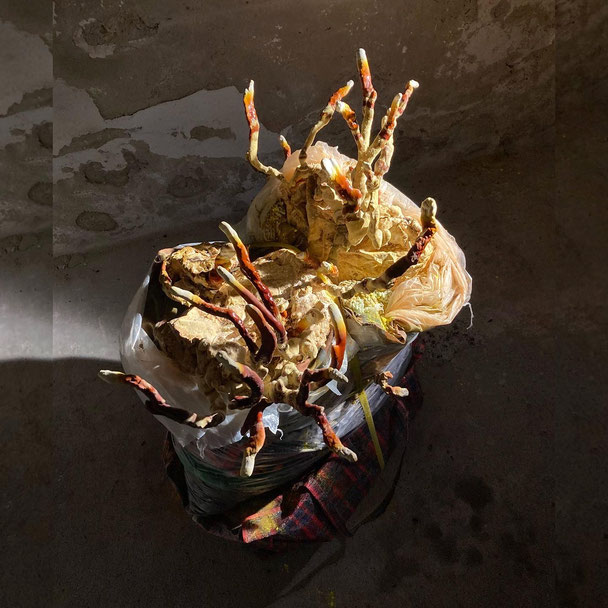
Background: Fashion is not meant to last. It’s adored only for the moment, nowadays all the more ephemeral. But we hardly ever think about where it goes once it’s past. The tale of an industry responsible for over 10 percent of global carbon emissions is far from chic: globally millions of tons of textiles waste is created each year, almost two-thirds of clothing cast-offs are heading directly to dumping grounds and another 10 percent are getting incinerated. Export to the Global South does not only ruin local markets, landfills overseas are heaping up. Today you can even see a massive mountain of fast-fashion landfill in the Atacama Desert from space. It can take up to 250 years for synthetic fibres to decompose. The contaminated fantasy needs an urgent metamorphosis.
MYCOREMEDIATION: Fungi, as decomposers and transformers, can grow new life (mushrooms) from dead and toxic material through the process of mycoremediation (from ancient Greek μύκης (mukēs) "fungus", and Latin remedium "restoration of balance"). Reishi is used to repair or restore the weakened immune systems of humans and environments. Due to the structural similarity between lignin (the organic substance binding wood), Reishi mushrooms can be employed for the degradation of persistent organic and inorganic contaminants, such as polyester fibres.

Installation with: Ganoderma lingzhi, Reishi mushrooms, growing on a bag and bale with fast-fashion throwaways. Furthermore: pigment powder, soil, plastic bag and foil, PET strapping band.
All materials used (except for the paperworks and garbage bag) are recycled or organic. The clothing cast-offs and bags I collected in my surrounding.

Reishi topping fashion waste (detail instalation)
AGENTS for REGENERATION
& Decomposition*
*there can not be regeneration if there is no deregeneration or decomposition, Giuliana Furci

Above: Reishi claw - tentacles pointing out from the backside of the clothing bale
Right: Frontside of the sculpture

A landfill with fast-fashion-remains in the Atacama Desert in Chile can now be seen from space
More than 66,000 tons of clothes reside at the massive landfill which is now visible from Space
thanks to high-resolution satellite images. Due to all the waste in the Atacama landfill,
the United Nations has declared the site as “an environmental
and social emergency” for the planet.” June 2023


Publication with Wardrobe Wasteland: A Tale of Metamorphosis
"Dwelling deep beneath, in shadowed soil, we fungi lurk unseen.
Yet, with our hyphal eyes, we've been eyeing you."
from Chronicles of the Earth's Underbelly

"Trust us, we have learned so much about other species. But dampened dreams,
in the last few decades we had quite a hard time making any sense of yours!
Vain as you are, you call it the Anthropocene. You should go for
Myceliocene instead. At least we know how to break things down
without breaking the biosphere."
from Chronicles of the Earth's Underbelly
Above the copies of the publication at the exhibition
A story from the perspective of the fungi about
how they experience fast-fashion waste fresh on their menu.
Below the cover drawing; entanglements of Reishi tentacles, fungal hyphae
and a digestive tract. Partly drawn by hand, partly edited on the computer

